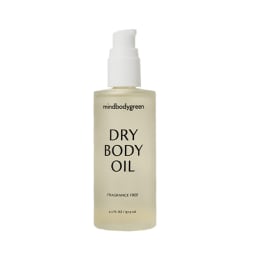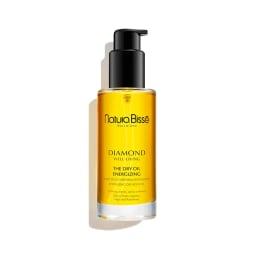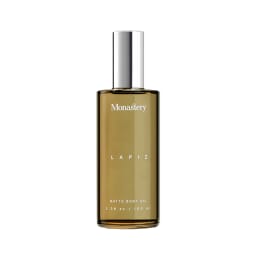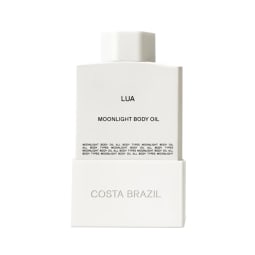Advertisement
What Is Dry Oil? Benefits For Skin, Hair & Nails + How To Use Them Correctly

If you're on the hunt for a new favorite body or facial oil, you've likely come across the term "dry oil." (Don't worry: If you're wondering how could something liquid and conditioning also be dry, we're here to clarify things for you.) Lately they've become incredibly popular for a reason: Their unique textures not only feel great on the skin, but they're more universally wearable for all skin types and often come chock-full of enhancing properties.
Is a dry oil something that will work for your skin and needs? Well, like many things in beauty, it all comes down to your personal taste—and we're here to help you make that decision.
What is a dry oil?
The term refers to the rate at which oil absorbs into the skin, not the consistency of the oil itself. Dry oils are those that are also described as "light" or "not greasy." Unlike thicker oils, they don't leave a lasting, noticeable residue on the body, so the skin feels dry after application. Folks who tend to prefer lightweight face creams and products tend to prefer dry oils over wet oils.
And the concept has been around for ages: Many herbalists, aromatherapists, and product formulators refer to dry oils as lightweight and quick-absorbing oils used in skin and hair care. Like many descriptors in the beauty industry, there is no hard-and-fast classification for which oils are defined as dry, but there is general consensus among beauty experts that they are high in polyunsaturated fatty acids, namely linoleic, and encompass vegetable, seed, and herbal oils.
Some of the most popular dry oils are:
- Safflower seed
- Sunflower seed
- Avocado
- Borage
- Rosehip seed
- Evening primrose
- Sesame
- Grapeseed,
- Camelina
- Squalane
Benefits for skin, hair & nails.
Dry oils are great go-to's for regular facial and body care, cuticle and nail T.L.C., and taming frizz and pesky flyaways. Let's break down the benefits:
Seals in moisture with a lightweight feel.
Oils, we know, are occlusives—they trap water into the skin and hair and keep the precious moisture from seeping out. But while dry oils are still classified as traditional carrier oils, they won’t leave a sticky feeling on the surface of your skin. One of the most common complaints with body oils that they can leave a residue on the skin, which can transfer to clothing, linens, and more. There's not the same concern with dry oils as the absorption rate is so much faster. By the time you go to put on your clothing, you'll be ready to go.
This also means they're a great option to spot treat throughout the day. If you want to use your dry oil as a cuticle oil or to pay closer attention to areas like your hands, it won't get in the way.
If you pick a dry oil for your hair, it also won't weigh down your strands. In fact, after a few minutes of applying dry oil on damp hair, you won’t even realize that you applied an oil—it sinks right in.
Full of antioxidants.
Each dry oil boasts a varied list of antioxidants and nutrients, but all of these antioxidants help stave free radicals, manage oxidative stress, and protect the skin and hair from UV rays and pollution. A few to call out:
- Safflower seed oil features polyphenols, flavonoids, carotenoids1, as well as vitamin E
- Sunflower seed oil boasts vitamin E
- Avocado oil contains vitamins A, C, E, K, B, and folate2
- Rosehip seed oil features vitamin C, which can also help collagen formulation in the skin
- Grapeseed oil has resveratrol and quercetin
Helps support a healthy skin barrier.
Fatty acids are essential for strengthening your skin barrier function, as they keep your skin cell's natural lipids nourished. Dry oils are chock-full of said fatty acids, especially linoleic acid, which research has shown can help maintain skin barrier integrity.3 In fact, another study showed that sunflower oil (a dry oil that contains linoleic acid) effectively hydrated the skin more than olive oil.
Best dry oils
Here, mindbodygreen’s beauty director Alexandra Engler highlights her favorite dry oils.
Pros
- Fragrance free
- For all skin types
- Botanical-based ingredients
Cons
- Not a noticeable scent, if you prefer your oils to be perfumed
Considerations::
Derm-approvedVeganCruelty-freeTravel-friendlySustainable packagingFragrance freeNaturally-derived ingredientsA body oil that checks all the dry oil boxes: Lightweight, effortless to apply, and fast-absorbing. It’s made with a blend of sunflower and organic safflower seed oils, as well as antioxidant-rich prickly pear seed oil, barrier-supporting squalane, and conditioning vitamin E. It locks in moisture to your outermost barrier, instantly restoring radiance to dull, lackluster skin.
Pros
- More than 90% of the ingredients are of natural origin (according to ISO 16128)
Cons
- Contains EOs if you’re sensitive to those
- Pricey
Considerations::
VeganSustainable packagingNaturally-derived ingredientsContains essential oilsThis luxury blend uses sunflower seed, carrot, and grape seed oils to achieve its dry, satin finish. It’s also topped with the nurturing antioxidant vitamin E, herbal oils (like sage and rosemary), as well as an uplifting essential oil cocktail (which includes lemon and orange peel oils).
Advertisement
Pros
- A more affordable price point
Cons
- Uses a spray application, which can be messy
Considerations::
VeganCruelty-freeNaturally-derived ingredientsContains essential oilsWhile this contains some oils that are typically considered “wet” oils, the overall finish is dry. Made with a base of coconut and sweet almond, it’s topped with lighter ingredients such as sunflower seed oil, calendula flower extract, ylang ylang essential oil, and vitamin E. Spray it on while you’re still in the shower for a more tidy application.
Pros
- Formulated by an esthetician
Cons
- Pricey
- Contains essential oils if you’re sensitive to them
Considerations::
Derm-approvedVeganCruelty-freeTravel-friendlySustainable packagingNaturally-derived ingredientsContains essential oilsOften, dry oils will be described as having a “matte” or “satin” finish, which just means you don’t get the overly shiny finish of heavier oils. This uses an olive-derived squalane from Italy as its base—infused with essential oils such as pink peppercorn, blue yarrow, and grapefruit. The squalane supports the skin barrier, while the organic essential oils provide an energizing, upbeat fragrance.
Advertisement
Pros
- Has a subtle sparkle to the formula
- Comes in two sizes
Cons
- Price
Considerations::
VeganCruelty-freeTravel-friendlySustainable packagingNaturally-derived ingredientsContains essential oilsThis brand uses several antioxidant-rich ingredients native to Brazil. In this body oils there’s cacay oil, babassu, avocado, passion fruit, and brazil nut seed oils. (Several are also certified organic and ECO-cert verified.) The oil is also infused with a subtle shimmer to give a soft moonlit glow.
Dry oils vs. wet oils.
Again, "dry" refers to how the oil sinks into the skin, not the texture of the oil itself. Meaning: Both dry and wet oils are, technically "wet." The difference is, wet oils are heavy on the skin and are slow to absorb. They often linger on top of the skin, like massage oil.
That's not to say wet oils aren't without their advantages: Wet oils take their time penetrating the dermis, which makes them great for relieving itchiness and chronic dryness. That's what makes them superb for inflammatory skin conditions. Some common wet oils are neem, coconut, castor, tamanu, baobab, sweet almond, hemp seed oil, and apricot kernel. Conventionally, these heavier oils have been the base of many water-based product formulations, like night creams. Due to their thicker, emollient nature, they're best for those looking for better moisture retention throughout the night.
And while you may find yourself identifying with one camp of oils more than the other, the truth is that many products on the market include a cocktail of both wet and dry oils for maximum benefits—unless, of course, you opt for the straight oil itself.
How to use dry oils.
If you’re interested in bringing more oils into your life, experiment with what works for you. There is not one oil protocol that’s effective for all skin types and goals. That said, here are some ways you can apply dry oils on hair, skin, and nails, but feel free to stick to what works best for you.
What's great about dry oils is they tend to be excellent multitaskers, so feel free to play around with them.
Using dry oil on skin.
- As the last step of your skin care routine, warm up a few drops of oil in your palms before pressing it into your face. You can do this over moisturizer if your skin runs dry, or use the oil alone to lock in hydration. Just make sure it's the last step of your routine—no serums or creams can penetrate the occlusive oil.
- Dry oils also make great body oils. After stepping out of the shower, apply a few drops of oil onto your skin and massage it in. Make sure your skin is still slightly damp—oils cannot trap water if there's no water underneath to trap.
- Because of the lighter texture, they can also be great for on the go applications for a subtle glow. If you want to show off shiny, healthy legs and limps, top your body care routine with a dry oil for an extra boost.
Using dry oil on hair.
- Apply one to two drops of your dry oil onto your hands, warming it up between your palms before massaging it into freshly washed hair in sections at a time. Start from the ends and work your way up, raking it through the strands.
- You can also drop some oil into your conditioner (three to five drops should do the trick) for a DIY hair mask.
- To apply on dry hair, warm one to two drops of oil in your palms before working it into your ends or smoothing down frizz or flyaways.
Using dry oil on nails.
- No surprise, these oils are great for cracked, frayed cuticles. Rub them in whenever your nail beds are begging for moisture, and especially after washing your hands.
- Since these oils sink in quite fast, chances are you won't have greasy fingers after the fact!
Cautions.
Dry oils in and of themselves don’t have any concerns, however, you may personally be sensitive or allergic to individual ingredients in a beauty product. That’s why it’s always important to read the ingredient label and patch test products before use—especially if you know your skin is highly sensitive or you have specific known allergens.
The takeaway.
If you're just starting to dabble in face or body oils, consider dry oils your starter pack. These moisturizing oils sink in quickly and feel quite weightless—so you won't sport slick skin. For more info on how to support your skin barrier, check out our guide.
























